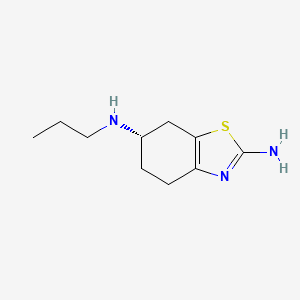
Pramipexole
Vue d'ensemble
Description
Le pramipexole est un médicament principalement utilisé pour traiter la maladie de Parkinson et le syndrome des jambes sans repos. Il s’agit d’un agoniste dopaminergique non-ergot qui mime l’activité de la dopamine, un neurotransmetteur dans le cerveau. Le this compound a été approuvé pour la première fois pour un usage médical aux États-Unis en 1997 .
Mécanisme D'action
Le pramipexole exerce ses effets en stimulant les récepteurs dopaminergiques dans le cerveau, en particulier les récepteurs D2, D3 et D4. En se liant à ces récepteurs, le this compound améliore l’activité de la dopamine, ce qui aide à soulager les symptômes de la maladie de Parkinson et du syndrome des jambes sans repos. Le mécanisme d’action exact n’est pas entièrement compris, mais on pense qu’il implique une modulation de la libération de neurotransmetteurs et des voies de signalisation neuronale .
Composés Similaires :
Ropinirole : Un autre agoniste dopaminergique non-ergot utilisé pour traiter la maladie de Parkinson et le syndrome des jambes sans repos.
Rotigotine : Un agoniste dopaminergique disponible sous forme de patch transdermique pour le traitement de la maladie de Parkinson et du syndrome des jambes sans repos.
Apomorphine : Un agoniste dopaminergique utilisé pour le traitement de la maladie de Parkinson, en particulier pour la gestion des épisodes « off ».
Unicité du this compound : Le this compound est unique en raison de sa forte affinité pour le récepteur D3, ce qui est censé contribuer à son efficacité dans le traitement de la maladie de Parkinson et du syndrome des jambes sans repos. De plus, le this compound a montré des propriétés neuroprotectrices et antioxydantes, ce qui en fait un candidat prometteur pour des recherches plus approfondies sur les maladies neurodégénératives .
Applications De Recherche Scientifique
Pramipexole has a wide range of scientific research applications:
Chemistry: Used as a model compound in studies of dopamine agonists.
Biology: Investigated for its effects on dopamine receptors and neurotransmission.
Medicine: Widely used in the treatment of Parkinson’s disease and restless legs syndrome. .
Industry: Employed in the development of new pharmaceuticals targeting dopamine receptors.
Analyse Biochimique
Biochemical Properties
Pramipexole interacts with dopamine receptors, specifically the D2, D3, and D4 subtypes . By binding to these receptors, this compound stimulates dopamine activity in the brain, which helps alleviate symptoms of Parkinson’s disease and RLS. The compound has a high affinity for the D3 receptor, which is believed to contribute to its efficacy in treating these conditions .
Cellular Effects
This compound influences various cellular processes, including cell signaling pathways, gene expression, and cellular metabolism. It has been shown to increase dopamine signaling in neurons, which helps restore normal motor function in patients with Parkinson’s disease . Additionally, this compound has neuroprotective effects, potentially due to its antioxidant properties and ability to stabilize mitochondria .
Molecular Mechanism
At the molecular level, this compound acts as an agonist for dopamine receptors, particularly the D2, D3, and D4 subtypes . By binding to these receptors, this compound stimulates dopamine activity in the brain, which helps alleviate symptoms of Parkinson’s disease and RLS. The compound also inhibits the release of somatostatin, a hormone that regulates the endocrine system .
Temporal Effects in Laboratory Settings
In laboratory settings, this compound has been shown to have stable effects over time. Studies have demonstrated that the compound maintains its efficacy in reducing symptoms of Parkinson’s disease and RLS over extended periods . Additionally, this compound has been found to have a long half-life, which contributes to its sustained effects .
Dosage Effects in Animal Models
In animal models, this compound has been shown to have dose-dependent effects. Lower doses of the compound are effective in alleviating symptoms of Parkinson’s disease and RLS, while higher doses can lead to adverse effects such as nausea, dizziness, and hallucinations . The optimal dosage of this compound varies depending on the specific condition being treated and the individual patient’s response to the medication .
Metabolic Pathways
This compound undergoes minimal metabolism in the human body, with the majority of the compound being excreted unchanged in the urine . This limited metabolism reduces the risk of drug interactions and makes this compound a relatively safe option for long-term use. The primary route of elimination is through the kidneys, with approximately 90% of the drug being excreted in the urine .
Transport and Distribution
This compound is extensively distributed throughout the body, with a volume of distribution of approximately 500 liters . The compound is about 15% bound to plasma proteins, which allows it to be readily available for interaction with dopamine receptors . This compound is also distributed into red blood cells, with an erythrocyte-to-plasma ratio of approximately 2 .
Subcellular Localization
This compound primarily localizes to the mitochondria within cells, where it exerts its neuroprotective effects by stabilizing mitochondrial function and reducing oxidative stress . This subcellular localization is crucial for the compound’s ability to protect neurons from damage and maintain normal cellular function.
Méthodes De Préparation
Voies de synthèse et conditions de réaction : La synthèse du pramipexole implique la réaction du (S)-2,6-diamino-4,5,6,7-tétrahydrobenzothiazole avec un agent alkylant. Cette réaction est réalisée en l’absence de base, dans un solvant duquel le produit N-monoalkylé résultant précipite sélectivement sous forme de sel. Le sel est ensuite traité avec une base inorganique pour le convertir en la base de this compound libre, qui peut être ensuite convertie en sels pharmaceutiquement acceptables .
Méthodes de production industrielle : Dans les milieux industriels, le this compound est produit en utilisant un processus en plusieurs étapes. En commençant par le 4-aminocyclohexanol, le composé subit des réactions d’acylation, d’oxydation, d’alpha-halogénation, de fermeture de cycle, d’hydrolyse, de résolution, de propionylation et de réduction pour obtenir le this compound. Le produit final peut être converti en chlorhydrate de this compound par une réaction de formation de sel avec de l’acide chlorhydrique .
Analyse Des Réactions Chimiques
Types de réactions : Le pramipexole subit diverses réactions chimiques, notamment :
Oxydation : Implique l’utilisation d’agents oxydants tels que l’acide trichloroisocyanurique.
Réduction : Utilise des agents réducteurs tels que le borohydrure de sodium et le borane.
Substitution : Implique le remplacement de groupes fonctionnels au sein de la molécule.
Réactifs et conditions courantes :
Oxydation : L’acide trichloroisocyanurique est utilisé comme oxydant.
Réduction : Le borohydrure de sodium et le borane sont des agents réducteurs courants.
Substitution : Divers agents alkylants sont utilisés pour les réactions de substitution.
Principaux produits : Les principaux produits formés à partir de ces réactions comprennent la base de this compound et ses sels pharmaceutiquement acceptables, tels que le chlorhydrate de this compound .
4. Applications de la Recherche Scientifique
Le this compound a un large éventail d’applications de recherche scientifique :
Chimie : Utilisé comme composé modèle dans des études sur les agonistes dopaminergiques.
Biologie : Investigué pour ses effets sur les récepteurs dopaminergiques et la neurotransmission.
Médecine : Largement utilisé dans le traitement de la maladie de Parkinson et du syndrome des jambes sans repos. .
Industrie : Employé dans le développement de nouveaux médicaments ciblant les récepteurs dopaminergiques.
Comparaison Avec Des Composés Similaires
Ropinirole: Another non-ergot dopamine agonist used to treat Parkinson’s disease and restless legs syndrome.
Rotigotine: A dopamine agonist available as a transdermal patch for the treatment of Parkinson’s disease and restless legs syndrome.
Apomorphine: A dopamine agonist used for the treatment of Parkinson’s disease, particularly for managing “off” episodes.
Uniqueness of Pramipexole: this compound is unique due to its high affinity for the D3 receptor, which is thought to contribute to its efficacy in treating Parkinson’s disease and restless legs syndrome. Additionally, this compound has been shown to have neuroprotective and antioxidant properties, making it a promising candidate for further research in neurodegenerative diseases .
Propriétés
IUPAC Name |
(6S)-6-N-propyl-4,5,6,7-tetrahydro-1,3-benzothiazole-2,6-diamine | |
|---|---|---|
| Source | PubChem | |
| URL | https://pubchem.ncbi.nlm.nih.gov | |
| Description | Data deposited in or computed by PubChem | |
InChI |
InChI=1S/C10H17N3S/c1-2-5-12-7-3-4-8-9(6-7)14-10(11)13-8/h7,12H,2-6H2,1H3,(H2,11,13)/t7-/m0/s1 | |
| Source | PubChem | |
| URL | https://pubchem.ncbi.nlm.nih.gov | |
| Description | Data deposited in or computed by PubChem | |
InChI Key |
FASDKYOPVNHBLU-ZETCQYMHSA-N | |
| Source | PubChem | |
| URL | https://pubchem.ncbi.nlm.nih.gov | |
| Description | Data deposited in or computed by PubChem | |
Canonical SMILES |
CCCNC1CCC2=C(C1)SC(=N2)N | |
| Source | PubChem | |
| URL | https://pubchem.ncbi.nlm.nih.gov | |
| Description | Data deposited in or computed by PubChem | |
Isomeric SMILES |
CCCN[C@H]1CCC2=C(C1)SC(=N2)N | |
| Source | PubChem | |
| URL | https://pubchem.ncbi.nlm.nih.gov | |
| Description | Data deposited in or computed by PubChem | |
Molecular Formula |
C10H17N3S | |
| Source | PubChem | |
| URL | https://pubchem.ncbi.nlm.nih.gov | |
| Description | Data deposited in or computed by PubChem | |
DSSTOX Substance ID |
DTXSID6023496 | |
| Record name | Pramipexole | |
| Source | EPA DSSTox | |
| URL | https://comptox.epa.gov/dashboard/DTXSID6023496 | |
| Description | DSSTox provides a high quality public chemistry resource for supporting improved predictive toxicology. | |
Molecular Weight |
211.33 g/mol | |
| Source | PubChem | |
| URL | https://pubchem.ncbi.nlm.nih.gov | |
| Description | Data deposited in or computed by PubChem | |
Physical Description |
Solid | |
| Record name | Pramipexole | |
| Source | Human Metabolome Database (HMDB) | |
| URL | http://www.hmdb.ca/metabolites/HMDB0014557 | |
| Description | The Human Metabolome Database (HMDB) is a freely available electronic database containing detailed information about small molecule metabolites found in the human body. | |
| Explanation | HMDB is offered to the public as a freely available resource. Use and re-distribution of the data, in whole or in part, for commercial purposes requires explicit permission of the authors and explicit acknowledgment of the source material (HMDB) and the original publication (see the HMDB citing page). We ask that users who download significant portions of the database cite the HMDB paper in any resulting publications. | |
Solubility |
freely soluble in water, 1.40e-01 g/L | |
| Record name | Pramipexole | |
| Source | DrugBank | |
| URL | https://www.drugbank.ca/drugs/DB00413 | |
| Description | The DrugBank database is a unique bioinformatics and cheminformatics resource that combines detailed drug (i.e. chemical, pharmacological and pharmaceutical) data with comprehensive drug target (i.e. sequence, structure, and pathway) information. | |
| Explanation | Creative Common's Attribution-NonCommercial 4.0 International License (http://creativecommons.org/licenses/by-nc/4.0/legalcode) | |
| Record name | Pramipexole | |
| Source | Human Metabolome Database (HMDB) | |
| URL | http://www.hmdb.ca/metabolites/HMDB0014557 | |
| Description | The Human Metabolome Database (HMDB) is a freely available electronic database containing detailed information about small molecule metabolites found in the human body. | |
| Explanation | HMDB is offered to the public as a freely available resource. Use and re-distribution of the data, in whole or in part, for commercial purposes requires explicit permission of the authors and explicit acknowledgment of the source material (HMDB) and the original publication (see the HMDB citing page). We ask that users who download significant portions of the database cite the HMDB paper in any resulting publications. | |
Mechanism of Action |
The exact mechanism of action of pramipexole as a treatment for Parkinson's disease is unknown at this time. It is thought, however, that the ability of pramipexole to cause stimulation of the dopamine receptors in the striatum of the brain, a region that receives a vast array of neurological input and is responsible for a wide variety of functions, may be involved. Studies performed in animals show that pramipexole influences striatal neuronal transmission rates following activation of dopamine receptors. Pramipexole is considered a non-ergot dopamine agonist that shows specificity and strong activity at the D2 subfamily of dopamine receptors in vitro, binding selectively and dopamine D2 receptors and showing a preference for the dopamine D3 receptor subtype rather than other subtypes. The clinical significance of this binding specificity is unknown,., The purpose of this study was to determine the binding sites of pramipexole in extrastriatal dopaminergic regions because its antidepressive effects have been speculated to occur by activating the dopamine D(2) receptor subfamily in extrastriatal areas. Dynamic positron emission tomography (PET) scanning using (11)C-FLB 457 for quantification of D(2)/D(3) receptor subtype was performed on 15 healthy volunteers. Each subject underwent two PET scans before and after receiving a single dose of pramipexole (0, 0.125, or 0.25 mg). The study demonstrated that pramipexole significantly binds to D(2)/D(3) receptors in the prefrontal cortex, amygdala, and medial and lateral thalamus at a dose of 0.25 mg. These regions have been indicated to have some relation to depression and may be part of the target sites where pramipexole exerts its antidepressive effects., Pramipexole dihydrochloride, a synthetic benzothiazolamine derivative, is a nonergot-derivative dopamine receptor agonist. In in vitro binding studies, pramipexole demonstrated high binding specificity for and intrinsic activity at dopamine D2 receptors compared with other dopamine receptor agonists (e.g., bromocriptine, pergolide), having a higher affinity for the D3 receptor subtype than for the D2 or D4 subtypes. Pramipexole binds with moderate affinity to alpha2-adrenergic receptors but has little or no affinity for alpha1- or beta-adrenergic, acetylcholine, dopamine D1, or serotonin (5-hydroxytryptamine (5-HT)) receptors., Our aim was to determine if pramipexole, a D3 preferring agonist, effectively reduced dopamine neuron and fiber loss in the 1-methyl-4-phenyl-1,2,3,6-tetrahydropyridine (MPTP) mouse model when given at intraperitoneal doses corresponding to clinical doses. We also determined whether subchronic treatment with pramipexole regulates dopamine transporter function, thereby reducing intracellular transport of the active metabolite of MPTP, 1-methyl-4-phenylpyridinium (MPP+). Ten 12-month old C57BL/6 mice were treated with MPTP (or saline) twice per day at 20 mg/kg s.c. (4 injections over 48 h). Mice were pretreated for 3 days and during the 2-day MPTP regimen with pramipexole (0.1 mg/kg/day) or saline. Stereological quantification of dopamine neuron number and optical density measurement of dopamine fiber loss were carried out at 1 week after treatment, using immunostaining for dopamine transporter (DAT) and tyrosine hydroxylase (TH). Additional wild-type (WT) and D3 receptor knockout (KO) mice were treated for 5 days with pramipexole (0.1 mg/kg/day) or vehicle. The kinetics of (3)H-MPP+ and (3)H-DA uptake (Vmax and Km) were determined 24 hr later; and at 24 hr and 14 days dopamine transporter density was measured by quantitative autoradiography. Pramipexole treatment completely antagonized the neurotoxic effects of MPTP, as measured by substantia nigra and ventral tegmental area TH-immunoreactive cell counts. MPTP- induced loss of striatal innervation, as measured by DAT-immunoreactivity, was partially prevented by pramipexole, but not with regard to TH-IR. Pramipexole also reduced DAT- immunoreactivity in non-MPTP treated mice. Subchronic treatment with pramipexole lowered the Vmax for (3)H-DA and (3)H-MPP+ uptake into striatal synaptosomes of WT mice. Pramipexole treatment lowered Vmax in WT but not D3 KO mice; however, D3 KO mice had lower Vmax for (3)H-DA uptake. There was no change in DAT number in WT with pramipexole treatment or D3 KO mice at 24 hr post-treatment, but there was a reduction in WT-pramipexole treated and not in D3 KO mice at 14 days post-treatment. These results suggest that protection occurs at clinically suitable doses of pramipexole. Protection could be due to a reduced amount of MPP+ taken up into DA terminals via DAT. D3 receptor plays an important role in this regulation of transporter uptake and availability. | |
| Record name | Pramipexole | |
| Source | DrugBank | |
| URL | https://www.drugbank.ca/drugs/DB00413 | |
| Description | The DrugBank database is a unique bioinformatics and cheminformatics resource that combines detailed drug (i.e. chemical, pharmacological and pharmaceutical) data with comprehensive drug target (i.e. sequence, structure, and pathway) information. | |
| Explanation | Creative Common's Attribution-NonCommercial 4.0 International License (http://creativecommons.org/licenses/by-nc/4.0/legalcode) | |
| Record name | PRAMIPEXOLE | |
| Source | Hazardous Substances Data Bank (HSDB) | |
| URL | https://pubchem.ncbi.nlm.nih.gov/source/hsdb/8253 | |
| Description | The Hazardous Substances Data Bank (HSDB) is a toxicology database that focuses on the toxicology of potentially hazardous chemicals. It provides information on human exposure, industrial hygiene, emergency handling procedures, environmental fate, regulatory requirements, nanomaterials, and related areas. The information in HSDB has been assessed by a Scientific Review Panel. | |
CAS No. |
104632-26-0 | |
| Record name | Pramipexole | |
| Source | CAS Common Chemistry | |
| URL | https://commonchemistry.cas.org/detail?cas_rn=104632-26-0 | |
| Description | CAS Common Chemistry is an open community resource for accessing chemical information. Nearly 500,000 chemical substances from CAS REGISTRY cover areas of community interest, including common and frequently regulated chemicals, and those relevant to high school and undergraduate chemistry classes. This chemical information, curated by our expert scientists, is provided in alignment with our mission as a division of the American Chemical Society. | |
| Explanation | The data from CAS Common Chemistry is provided under a CC-BY-NC 4.0 license, unless otherwise stated. | |
| Record name | Pramipexole [USAN:INN:BAN] | |
| Source | ChemIDplus | |
| URL | https://pubchem.ncbi.nlm.nih.gov/substance/?source=chemidplus&sourceid=0104632260 | |
| Description | ChemIDplus is a free, web search system that provides access to the structure and nomenclature authority files used for the identification of chemical substances cited in National Library of Medicine (NLM) databases, including the TOXNET system. | |
| Record name | Pramipexole | |
| Source | DrugBank | |
| URL | https://www.drugbank.ca/drugs/DB00413 | |
| Description | The DrugBank database is a unique bioinformatics and cheminformatics resource that combines detailed drug (i.e. chemical, pharmacological and pharmaceutical) data with comprehensive drug target (i.e. sequence, structure, and pathway) information. | |
| Explanation | Creative Common's Attribution-NonCommercial 4.0 International License (http://creativecommons.org/licenses/by-nc/4.0/legalcode) | |
| Record name | Pramipexole | |
| Source | EPA DSSTox | |
| URL | https://comptox.epa.gov/dashboard/DTXSID6023496 | |
| Description | DSSTox provides a high quality public chemistry resource for supporting improved predictive toxicology. | |
| Record name | (S)-2-Amino-6-propylamino-4,5,6,7-tetrahydrobenzothiazole | |
| Source | European Chemicals Agency (ECHA) | |
| URL | https://echa.europa.eu/substance-information/-/substanceinfo/100.124.761 | |
| Description | The European Chemicals Agency (ECHA) is an agency of the European Union which is the driving force among regulatory authorities in implementing the EU's groundbreaking chemicals legislation for the benefit of human health and the environment as well as for innovation and competitiveness. | |
| Explanation | Use of the information, documents and data from the ECHA website is subject to the terms and conditions of this Legal Notice, and subject to other binding limitations provided for under applicable law, the information, documents and data made available on the ECHA website may be reproduced, distributed and/or used, totally or in part, for non-commercial purposes provided that ECHA is acknowledged as the source: "Source: European Chemicals Agency, http://echa.europa.eu/". Such acknowledgement must be included in each copy of the material. ECHA permits and encourages organisations and individuals to create links to the ECHA website under the following cumulative conditions: Links can only be made to webpages that provide a link to the Legal Notice page. | |
| Record name | PRAMIPEXOLE | |
| Source | FDA Global Substance Registration System (GSRS) | |
| URL | https://gsrs.ncats.nih.gov/ginas/app/beta/substances/83619PEU5T | |
| Description | The FDA Global Substance Registration System (GSRS) enables the efficient and accurate exchange of information on what substances are in regulated products. Instead of relying on names, which vary across regulatory domains, countries, and regions, the GSRS knowledge base makes it possible for substances to be defined by standardized, scientific descriptions. | |
| Explanation | Unless otherwise noted, the contents of the FDA website (www.fda.gov), both text and graphics, are not copyrighted. They are in the public domain and may be republished, reprinted and otherwise used freely by anyone without the need to obtain permission from FDA. Credit to the U.S. Food and Drug Administration as the source is appreciated but not required. | |
| Record name | PRAMIPEXOLE | |
| Source | Hazardous Substances Data Bank (HSDB) | |
| URL | https://pubchem.ncbi.nlm.nih.gov/source/hsdb/8253 | |
| Description | The Hazardous Substances Data Bank (HSDB) is a toxicology database that focuses on the toxicology of potentially hazardous chemicals. It provides information on human exposure, industrial hygiene, emergency handling procedures, environmental fate, regulatory requirements, nanomaterials, and related areas. The information in HSDB has been assessed by a Scientific Review Panel. | |
| Record name | Pramipexole | |
| Source | Human Metabolome Database (HMDB) | |
| URL | http://www.hmdb.ca/metabolites/HMDB0014557 | |
| Description | The Human Metabolome Database (HMDB) is a freely available electronic database containing detailed information about small molecule metabolites found in the human body. | |
| Explanation | HMDB is offered to the public as a freely available resource. Use and re-distribution of the data, in whole or in part, for commercial purposes requires explicit permission of the authors and explicit acknowledgment of the source material (HMDB) and the original publication (see the HMDB citing page). We ask that users who download significant portions of the database cite the HMDB paper in any resulting publications. | |
Melting Point |
288-290 | |
| Record name | Pramipexole | |
| Source | DrugBank | |
| URL | https://www.drugbank.ca/drugs/DB00413 | |
| Description | The DrugBank database is a unique bioinformatics and cheminformatics resource that combines detailed drug (i.e. chemical, pharmacological and pharmaceutical) data with comprehensive drug target (i.e. sequence, structure, and pathway) information. | |
| Explanation | Creative Common's Attribution-NonCommercial 4.0 International License (http://creativecommons.org/licenses/by-nc/4.0/legalcode) | |
Synthesis routes and methods
Procedure details





Retrosynthesis Analysis
AI-Powered Synthesis Planning: Our tool employs the Template_relevance Pistachio, Template_relevance Bkms_metabolic, Template_relevance Pistachio_ringbreaker, Template_relevance Reaxys, Template_relevance Reaxys_biocatalysis model, leveraging a vast database of chemical reactions to predict feasible synthetic routes.
One-Step Synthesis Focus: Specifically designed for one-step synthesis, it provides concise and direct routes for your target compounds, streamlining the synthesis process.
Accurate Predictions: Utilizing the extensive PISTACHIO, BKMS_METABOLIC, PISTACHIO_RINGBREAKER, REAXYS, REAXYS_BIOCATALYSIS database, our tool offers high-accuracy predictions, reflecting the latest in chemical research and data.
Strategy Settings
| Precursor scoring | Relevance Heuristic |
|---|---|
| Min. plausibility | 0.01 |
| Model | Template_relevance |
| Template Set | Pistachio/Bkms_metabolic/Pistachio_ringbreaker/Reaxys/Reaxys_biocatalysis |
| Top-N result to add to graph | 6 |
Feasible Synthetic Routes
Avertissement et informations sur les produits de recherche in vitro
Veuillez noter que tous les articles et informations sur les produits présentés sur BenchChem sont destinés uniquement à des fins informatives. Les produits disponibles à l'achat sur BenchChem sont spécifiquement conçus pour des études in vitro, qui sont réalisées en dehors des organismes vivants. Les études in vitro, dérivées du terme latin "in verre", impliquent des expériences réalisées dans des environnements de laboratoire contrôlés à l'aide de cellules ou de tissus. Il est important de noter que ces produits ne sont pas classés comme médicaments et n'ont pas reçu l'approbation de la FDA pour la prévention, le traitement ou la guérison de toute condition médicale, affection ou maladie. Nous devons souligner que toute forme d'introduction corporelle de ces produits chez les humains ou les animaux est strictement interdite par la loi. Il est essentiel de respecter ces directives pour assurer la conformité aux normes légales et éthiques en matière de recherche et d'expérimentation.
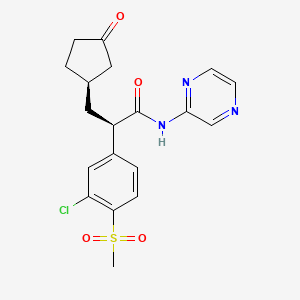
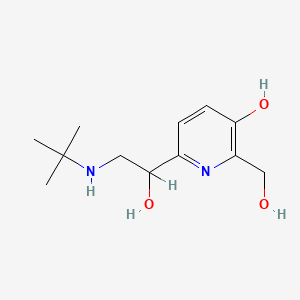
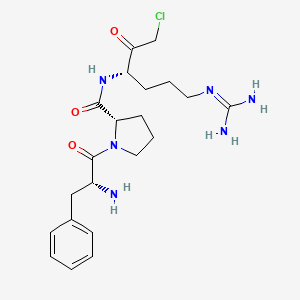
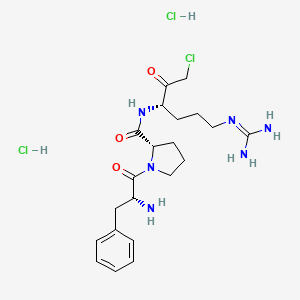
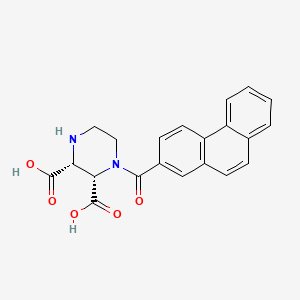
![1-Chloro-4-[2-chloro-1-(4-chlorophenyl)ethyl]benzene](/img/structure/B1677968.png)

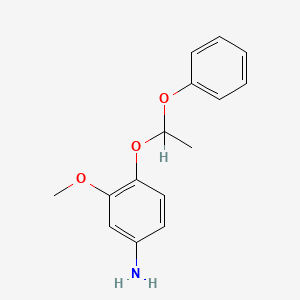

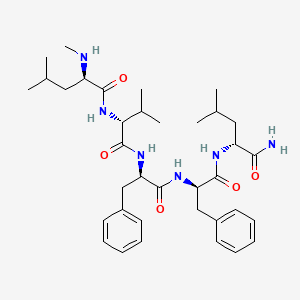
![2-(Chloromethyl)-5-(4-fluorophenyl)thieno[2,3-d]pyrimidin-4-ol](/img/structure/B1677975.png)
![(1S,5S)-(1-{5-[(4-amino-benzenesulfonyl)-isobutyl-amino]-6-phosphonooxy hexylcarbamoyl}-2,2-diphenyl-ethyl)-carbamic acid methyl ester](/img/structure/B1677976.png)
![13-(2-Fluorophenyl)-3,5,10,10-tetramethyl-8-phenyl-12-oxa-3,5,9-triazatricyclo[7.4.0.02,7]trideca-1,7-diene-4,6-dione](/img/structure/B1677977.png)

